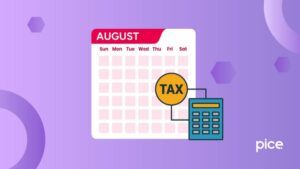A Guide to Reversal of Input Tax Credit Under GST and its Eligibility
- 20 Sep 24
- 20 mins

A Guide to Reversal of Input Tax Credit Under GST and its Eligibility
- What is the Input Tax Credit (ITC)?
- Eligible and Ineligible Input Tax Credit Details
- Eligibility and Conditions for Claiming ITC
- How to Calculate ITC?
- What Does the Reversal of ITC Mean?
- Recent Conditions for Claiming ITC
- Reversal of ITC: Provisions
- Procedural Aspects of ITC Reversal
- Reversal of ITC on Account of Non-Compliance by the Supplier
- How to Report ITC Reversal in GSTR-2
- Conclusion
Key Takeaways
- ITC Reversal is Necessary for Compliance: Input tax credits must be reversed in specific circumstances,, such as non-payment to suppliers or use of inputs for non-business purposes, to maintain GST compliance.
- Accurate documentation is crucial. Keeping accurate and comprehensive records is essential for justifying ITC claims and facilitating necessary reversals.
- Reconciliation Aids Accuracy: Regular reconciliation of purchase records with GSTR-2A and GSTR-3B ensures that ITC claims and reversals are accurate and justified.
- Timely Reporting Reduces Liabilities: Reporting ITC reversals in the correct tax period, primarily through GSTR-3B, helps prevent penalties and interest on discrepancies.
The Goods and Services Tax (GST) framework in India has revolutionized the indirect tax landscape, introducing the concept of Input Tax Credit (ITC) as its backbone. This mechanism allows businesses to reduce their tax liability by claiming credit for the taxes paid on inputs. However, under certain circumstances, this credit needs to be reversed, which is a critical aspect to understand for compliance and optimal payment of tax planning.
What is the Input Tax Credit (ITC)?
The Input Tax Credit (ITC) is a mechanism within many tax systems, particularly under the Goods and Services Tax (GST) framework, that allows businesses to reduce their tax liability by claiming a credit of tax paid on purchases. Essentially, it is a credit for the taxes paid on inputs used to manufacture goods or provide services that are later sold.
Here's how it works:
- Tax on Purchases: When a business purchases goods or services, they pay GST on these purchases.
- Tax on Sales: The business also collects GST from its customers when it sells goods or services.
- Offsetting Credit: The GST paid on purchases can be used as a credit to reduce the GST payable on sales. This prevents the same tax from being paid multiple times in the inwards supply chain.
The primary objective of ITC is to eliminate the cascading effect of taxes, where tax is paid on tax, throughout the supply chain. This makes the overall tax burden on the final consumer lower and the pricing of goods and services more competitive. Businesses need to maintain accurate records and invoices to claim ITC and must comply with specific regulatory requirements to be eligible for this benefit.
Eligible and Ineligible Input Tax Credit Details
To harness the benefits of ITC, businesses must discern between conditions for eligibility and ineligibility credits. Below is the table that describes what is eligible and ineligible for ITC.
| Category | Eligible for ITC | Ineligible for ITC |
|---|---|---|
| Raw Materials | ✓ | |
| Capital Goods | ✓ | |
| Services (Business-related) | ✓ | |
| Goods for Resale | ✓ | |
| Rent, Fees, and Charges | ✓ | |
| Personal Use | ✓ | |
| Exempt Supplies | ✓ | |
| Motor Vehicles and Conveyances | Only if used for business purposes | Typically ineligible unless for business-specific uses |
| Food and Beverages, Outdoor Catering | ✓ | |
| Membership Fees (Clubs, Health Centers) | ✓ | |
| Travel Benefits to Employees | ✓ |
Eligibility and Conditions for Claiming ITC
To maximize compliance and proper utilization of the eligible ITC, businesses need to meet the following conditions:
- The taxpayer should be in possession of a tax invoice or debit note issued by a registered supplier.
- The taxpayer must have received the goods and/or services.
- The tax charged in respect of such supply must have been actually paid to the government either in cash or through the utilization of input tax credit.
- The taxpayer should have furnished the GST return.
How to Calculate ITC?

Calculating the Input Tax Credit (ITC) accurately is a crucial aspect of compliance under the Goods and Services Tax (GST) framework. ITC allows businesses to reduce the amount of GST they have to pay by crediting them for the taxes paid on their purchases.
Here's a step-by-step guide on how to calculate
Step 1: Identify Eligible Purchases
First, you need to identify which purchases are eligible for ITC. This includes goods and services used for the business that are not for personal use, not exempt from GST, and not exclusively used for making non-GST, non-taxable supplies used for personal consumption.
Step 2: Accumulate GST Invoices
Collect all valid GST invoices related to these purchases. The invoices must contain all the necessary details required by GST regulations, such as GSTIN of the supplier, the tax amount, description of goods or services, etc.
Step 3: Check for Invoice Matching in GSTR-2A/2B
Verify that the GST details on your purchases (as per your records and invoices) match with the details in GSTR-2A or GSTR-2B. GSTR-2A/2B is a system-generated statement that shows the invoices uploaded by your suppliers. This step is essential to ensuring that the suppliers have indeed paid the corresponding GST to the government.
Step 4: Calculate Total Eligible ITC
Sum up the GST amounts from all eligible invoices. This total represents the gross ITC available to you for the period (usually monthly).
Step 5: Apply Reversal Rules if Applicable
Deduct any ITC that needs to be reversed due to reasons such as non-payment of invoices within 180 day period, usage of goods or services for non-business or exempt supplies, etc. Specific rules and rates (like Rule 42 and Rule 43 for mixed supplies) may need to be applied to calculate the exact amount of reversal.
Step 6: Consider Input Tax Apportionment
If you have used goods or services for both taxable and non-taxable supplies, you will need to apportion the ITC. Only the portion of GST paid on inputs used for making taxable supplies can be claimed. This apportionment should be done based on a reasonable criterion like the value of supplies, usage of inputs, etc.
Step 7: Calculate Net Eligible ITC
Subtract the total reversed ITC from the gross ITC to find out the net ITC that can be claimed in your GST returns.
Example Calculation:
Suppose a business has made the following transactions in a month:
- Purchased raw materials worth INR 100,000 plus GST @ 18% (INR 18,000).
- Purchased office supplies are not eligible for ITC worth INR 10,000 plus GST @ 18% (INR 1,800).
- Purchased services for both taxable and exempt supplies worth INR 50,000 plus GST @ 18% (INR 9,000), with 30% used for exempt supplies.
- Total GST on purchases: INR 18,000 (raw materials) + INR 9,000 (services) = INR 27,000
- Reversal for exempt supplies (30% of INR 9,000): INR 2,700
- Net ITC: INR 27,000 - INR 2,700 = INR 24,300
This amount of INR 24,300 can be used to offset the GST liability on sales.
Time Limit to Claim ITC under GST
The GST framework specifies time limits for claiming ITC, typically by the due date of the return for September following the end of the financial year or the date of filing the annual return, whichever is earlier.
What Does the Reversal of ITC Mean?
he concept is crucial for maintaining the integrity and proper functioning of the GST system.

The reversal of Input Tax Credit (ITC) under the Goods and Services Tax (GST) framework refers to the process of undoing or negating the credit that has been claimed on inputs.
This occurs when the conditions under which the ITC was claimed change or are not met, leading to the requirement to pay back the credit to the government. The concept is crucial for maintaining the integrity and proper functioning of the GST system.
Reasons for ITC Reversal
There are several circumstances under which ITC reversal is required, including but not limited to:
- Non-payment to Supplier: If the payment to the supplier for the invoices is not made within 180 days of the invoice date, the credit availed on that purchase must be reversed.
- Personal or Exempt Use: If goods or services initially intended for business use are subsequently used for personal purposes or to make exempt supplies, the ITC claimed on such inputs needs to be reversed.
- Goods Returned or Unsold Stock: If goods are returned to the supplier or if unsold stock is written off, the ITC claimed on these goods needs to be reversed.
- Cancellation of GST Registration: Upon cancellation of GST registration, any remaining ITC needs to be reversed since the registrant will no longer be making taxable supplies.
- Change in Usage: Change in the use of inputs or capital goods from taxable to non-taxable purposes requires a proportionate reversal of the ITC claimed.
Mechanism of ITC Reversal
The process typically involves adjusting the credit in the electronic credit ledger of the taxpayer. The amount to be reversed is added to the output tax liability of the taxpayer for the month in which the reversal is required. The taxpayer must then pay the equivalent amount in cash, as the reversal increases the tax liability.
Compliance and Reporting
ITC reversals must be reported in the monthly return. Failure to comply with the reversal provisions can lead to penalties and interest charges, making accurate and timely reporting crucial. Businesses must maintain good records and monitor their ITC claims closely to ensure that reversals are handled correctly as and when they arise.
Recent Conditions for Claiming ITC
Recent changes and conditions for claiming Input Tax Credit (ITC) under the Goods and Services Tax (GST) system have been introduced to tighten compliance and ensure that only eligible credits are claimed. These adjustments are part of ongoing efforts to streamline the tax system and prevent misuse of the ITC mechanism. Here are some of the key recent conditions introduced for claiming ITC:
- Real-Time Matching of Invoices
To claim ITC, the details of the invoices uploaded by the suppliers in their GSTR-1 form must match with the details mentioned in the GSTR-2A or GSTR-2B of the recipient. This real-time data matching ensures transparency and confirms that the supplier has paid the government the tax charged.
- Strict Deadline Compliance
The GST law stipulates strict deadlines for the filing of returns. ITC can be claimed for a financial year up until the due date of the September return of the next financial year or the filing of the annual return, whichever is earlier return. This condition emphasizes timely compliance and better financial planning.
- Restriction Based on Vendor Compliance
ITC claims are now contingent on whether the suppliers have paid their respective GST dues. If the supplier fails to furnish their returns or remit the GST they collected, the ITC claimed by the recipient on those purchases will be denied. This condition puts an onus on businesses to vet their vendors and ensure they partner with compliant entities.
- Documentation and Reconciliation
Businesses must maintain robust documentation, including tax invoices, debit notes, and other prescribed documents. Furthermore, regular reconciliation between books of accounts and GST returns is essential for claiming ITC. Discrepancies can lead to denial or reversal of the credit.
- Rule 36(4) - Cap on Claiming ITC
A specific restriction, known as Rule 36(4), has been introduced, which limits the provisional ITC claims to 5% (previously 10% and 20%) of the eligible credits available in GSTR-2A. This rule aims to further enforce compliance and ensure that businesses do not claim excessive or unverified credits.
- Reversal of ITC on Non-payment
ITC has to be reversed if the payment for the invoices is not made to the suppliers within a 180 day period from the invoice date. This condition ensures that the credit is only availed of on actual payments, encouraging prompt business transactions.
- Conditions for Import of Services
For the import of services, the ITC can only be claimed if the import is used for business purposes and the GST on such services has been paid. This is to ensure that credit benefits are only claimed for business-related expenses.
Reversal of ITC: Provisions
The provisions for the reversal of input tax credit (ITC) under the Goods and Services Tax (GST) are critical to ensuring compliance and proper tax management. These provisions dictate the circumstances and the manner in which the reversal of ITC should occur, aiming to rectify instances where ITC has been incorrectly claimed or the conditions for its credit claim have changed. Here’s an overview of the key provisions related to the reversal of ITC:
Circumstances Requiring Reversal of ITC
The reversal of ITC may be necessitated under several scenarios:
- Non-payment of Invoice: If the recipient fails to pay the supplier within 180 days from the date of the invoice, the ITC initially claimed needs to be reversed. If the payment is made later, the ITC can be reclaimed.
- Personal or Exempt Use: When goods or services initially procured for business purposes are subsequently used for personal or exempt supplies (which do not attract GST), a corresponding reversal of ITC is required.
- Goods Returned or Destroyed: If goods are returned to the supplier or are destroyed, lost, or written off, the ITC claimed on such goods must be reversed.
- Cancellation of GST Registration: On cancellation of GST registration, any unutilized ITC needs to be reversed since the entity will no longer be liable to pay GST.
- Change in Usage or Business Structure: Changes in the business, such as converting an exempt supply to a taxable one or changes in the structure that affect tax liability, require an adjustment of previously claimed ITC.
Procedural Aspects of ITC Reversal
The GST law outlines specific procedures for the reversal of ITC:

- Adjustment in Returns: The amount to be reversed is usually added to the output tax liability in the GST returns for the period during which the reversal is required.
- Documentation: Proper documentation and records must be maintained to support the reversal, including the reasons and calculations for the reversal.
- Reporting: The details of the reversal must be clearly reported in the periodic GST filings, such as GSTR-1 and GSTR-3B.
- Specific Rules for Reversal
There are specific rules for calculating the amount of ITC to be reversed in various situations:
- Rule 42 & 43 of CGST Rules: These rules detail the procedure for reversal of ITC in cases of mixed supplies, i.e., where goods or services are used partly for taxable supplies and partly for exempt supplies.
- Pro rata Basis Reversal: In cases where assets are used both for business and non-business purposes, ITC has to be reversed on a pro rata basis according to the extent of non-business use.
Compliance and Penalties
Failure to comply with the reversal provisions can lead to penalties, interest, and other legal consequences. Therefore, it is crucial for businesses to monitor their ITC claims closely and ensure timely reversal where necessary to maintain compliance with GST laws.
Reversal of ITC on Account of Non-Compliance by the Supplier
ITC reversal on account of supplier non-compliance typically occurs under the following circumstances:
- Supplier Fails to File Returns: If the supplier does not file their GST returns, the tax amount they collect is not considered paid to the government. In such cases, the ITC claimed by the buyer (recipient of supplies) based on these purchases becomes ineligible and must be reversed.
- Supplier Fails to Pay Collected Tax: Even if the supplier has issued a tax invoice and the recipient has claimed ITC, if the supplier fails to remit the collected tax to the government within the stipulated time, the recipient’s ITC claim may be disallowed and required to be reversed.
- Mismatch in Invoicing: Discrepancies between the tax invoices issued by the supplier and the details filed in their GST returns can lead to denial or reversal of the claimed ITC by the recipient.
Process of ITC Reversal
The process of reversing the ITC due to supplier non-compliance involves several steps:
- Tracking via GSTR-2A/2B: The recipient must regularly review their GSTR-2A or GSTR-2B forms, which reflect the tax credits available based on suppliers' filed returns. Any discrepancies or non-filing by suppliers will be evident here.
- Reconciliation: Businesses must reconcile their purchase records with the GSTR-2A/2B statements to identify any mismatches or non-compliance issues. If an issue is identified, the business should follow up with the supplier to rectify the discrepancies.
- Reversal Entry: If the supplier fails to correct the non-compliance, the recipient must reverse the ITC claimed in their next GST return filing (usually in GSTR-3B). This involves adjusting the input tax credit against their output tax liability.
- Documentation: In the event that tax authorities challenge the reversal, maintaining proper documentation of communications with suppliers and records of reconciliation is essential.
Impact and Compliance
The implications of reversing ITC due to supplier non-compliance can be significant for businesses, as it directly affects their cash flows and tax liabilities. Hence, businesses are encouraged to:
- Vet Suppliers Carefully: Before engaging in significant transactions, evaluate the GST compliance history of suppliers.
- Maintain Strong Communication: Encourage suppliers to adhere to GST regulations and promptly rectify any compliance issues.
- Automate Reconciliation: Use accounting software or tools that automatically reconcile purchase records with GSTR-2A or Form GSTR-2B data to promptly identify discrepancies.
Legal Framework
The legal framework under GST imposes strict penalties not only on suppliers who fail to comply but also on recipients who fail to reverse ineligible ITC. Therefore, ensuring that all parties in the supply chain adhere to GST regulations is crucial for smooth business operations and compliance.
- ITC Reversal in GSTR-3B: The input tax credit (ITC) reversal in the GST system necessitates careful reporting, particularly in the GSTR-3B form, a monthly summary return filed by GST registrants. ITC reversal is reported in this form when the conditions under which ITC was claimed change or are found to be non-compliant with GST regulations. Here’s how ITC reversal is handled in GSTR-3B:
- Purpose of GSTR-3B: GSTR-3B is a consolidated summary return that GST taxpayers must file monthly. It includes details of sales and purchases, the tax collected on sales, the tax paid on purchases, and the net tax liability. Importantly, it also includes adjustments through ITC claims and reversals.
- Reporting ITC Reversal in GSTR-3B: When filing GSTR-3B, taxpayers must accurately report any reversals of ITC under the relevant sections. The process involves several key steps:
- Identification of Reversal Requirements: Before filing GSTR-3B, identify any situations requiring ITC reversal, such as non-payment to suppliers within 180 days, use of inputs for non-business or exempt purposes, or goods and services used for both taxable and exempt supplies.
- Calculation of Reversible ITC: Calculate the amount of ITC that needs to be reversed based on the rules applicable to the specific scenarios identified. This calculation must be accurate to ensure compliance and avoid future liabilities.
- Inputting Reversal Details in GSTR-3B: In GSTR-3B, the reversal of ITC is reported under Table 4(B) "Eligible ITC." The details of reversals are entered as follows:
- 4(B)(2): ITC Reversed: This field captures the total ITC that needs to be reversed due to reasons such as rule-based reversals (like Rule 42 & 43 for mixed supplies), non-compliance by suppliers, or any other stipulated reasons.
- Adjusting Net ITC Available: After reporting the reversed ITC, adjust the net ITC available for offsetting against the output tax liability. This ensures that only the eligible ITC, after accounting for necessary reversals, is utilized to discharge the tax liability.
- Payment of Additional Liability: If the ITC reversal results in additional tax liability (because the reversed ITC can no longer be used to offset the GST due on sales), ensure that this additional tax is paid in cash.
How to Report ITC Reversal in GSTR-2
Reporting the Input Tax Credit (ITC) reversal in GSTR-2 involves a hypothetical scenario since the filing of GSTR-2 is no longer required in the current GST regime. Instead, the information that would have been reported in GSTR-2 is primarily handled through Form GSTR-3B, a monthly summary return, and other forms. However, understanding the theoretical process can provide insight into the structure and intention behind the GST filing mechanisms.
Theoretical Process of Reporting ITC Reversal in GSTR-2:
- Identifying the Need for Reversal
Determine scenarios where ITC reversal is required. Common reasons include goods returned to the supplier, inputs used for personal or exempt supplies, and the failure of the supplier to pay the GST they collected.
- Document Collection
Gather all necessary documentation, such as revised invoices and credit notes from suppliers, that justify the reversal of ITC.
- Updating GSTR-2 Entries
If GSTR-2 were active, adjustments would be made directly in the form. Each line item related to a purchase that requires ITC reversal would be updated to reflect the corrected input tax credit amounts.
- Use of Specific Fields
The theoretical GSTR-2 form would likely include fields for reporting the original ITC claimed and the amount of ITC being reversed. These details would need to be filled out accurately to ensure compliance with the tax laws.
- Reconciliation with GSTR-2A
Reconcile the details in the updated Form GSTR-2 with the auto-populated GSTR-2A, which reflects the data filed by suppliers in their Form GSTR-1. This step is crucial to ensuring that both the buyer and the supplier acknowledge and accept all adjustments.
- Final Submission
After making all necessary revisions and ensuring all data is accurate, the finalized GSTR-2 would theoretically be submitted. This would include detailed information on the ITC reversals that have been processed during the period.
- Cross-Verification with GSTR-3B
Subsequently, adjustments noted in the GSTR-2 would need to be reflected in the GSTR- 3B Form to adjust the net ITC available for offset against the output tax liability.
Practical Application in Current Times
Since GSTR-2 is not in use, all such adjustments are currently made in the GSTR-3B form:

Section 4(B) of GSTR-3B: This section is used for detailing ITC reversed for any reason during the tax period. Taxpayers must report any ITC reversal due to reasons including but not limited to non-payment to suppliers, use of inputs for non-business purposes, and inputs used for making exempt supplies.
Importance of Accurate Reporting:
Accurate reporting of ITC and its reversal is essential to maintaining compliance with GST regulations. Incorrect reporting can lead to penalties, interest, or even more severe legal consequences. Regular audits and reconciliations can help businesses maintain compliance and ensure that their GST filings reflect their actual tax liabilities and credits accurately.
Conclusion
Having knowledge of the eligibility of input tax credits and their reversal is fundamental to maintaining GST compliance and optimizing tax credits. Businesses must stay updated with regulations and maintain rigorous documentation to fully leverage the ITC benefits.
💡Missing the deadline to pay GST payments? Download Pice and start using a credit card to pay GST on time, experience efficiency and convenience, and manage cash flow more effectively.
 By
By 

















